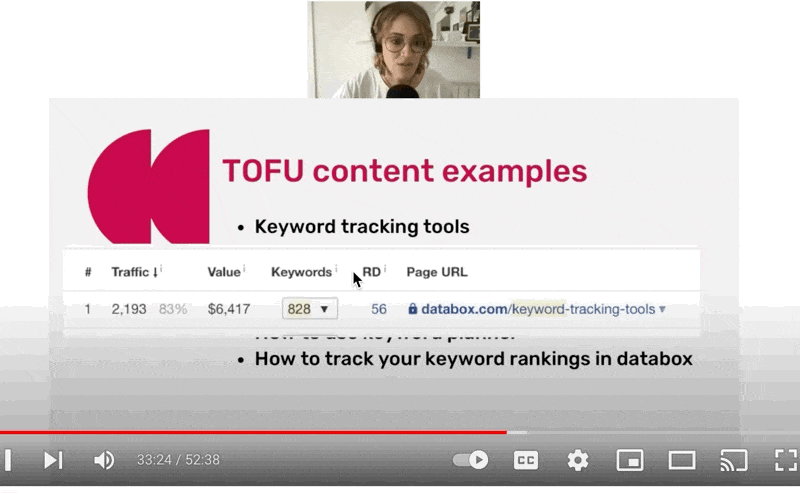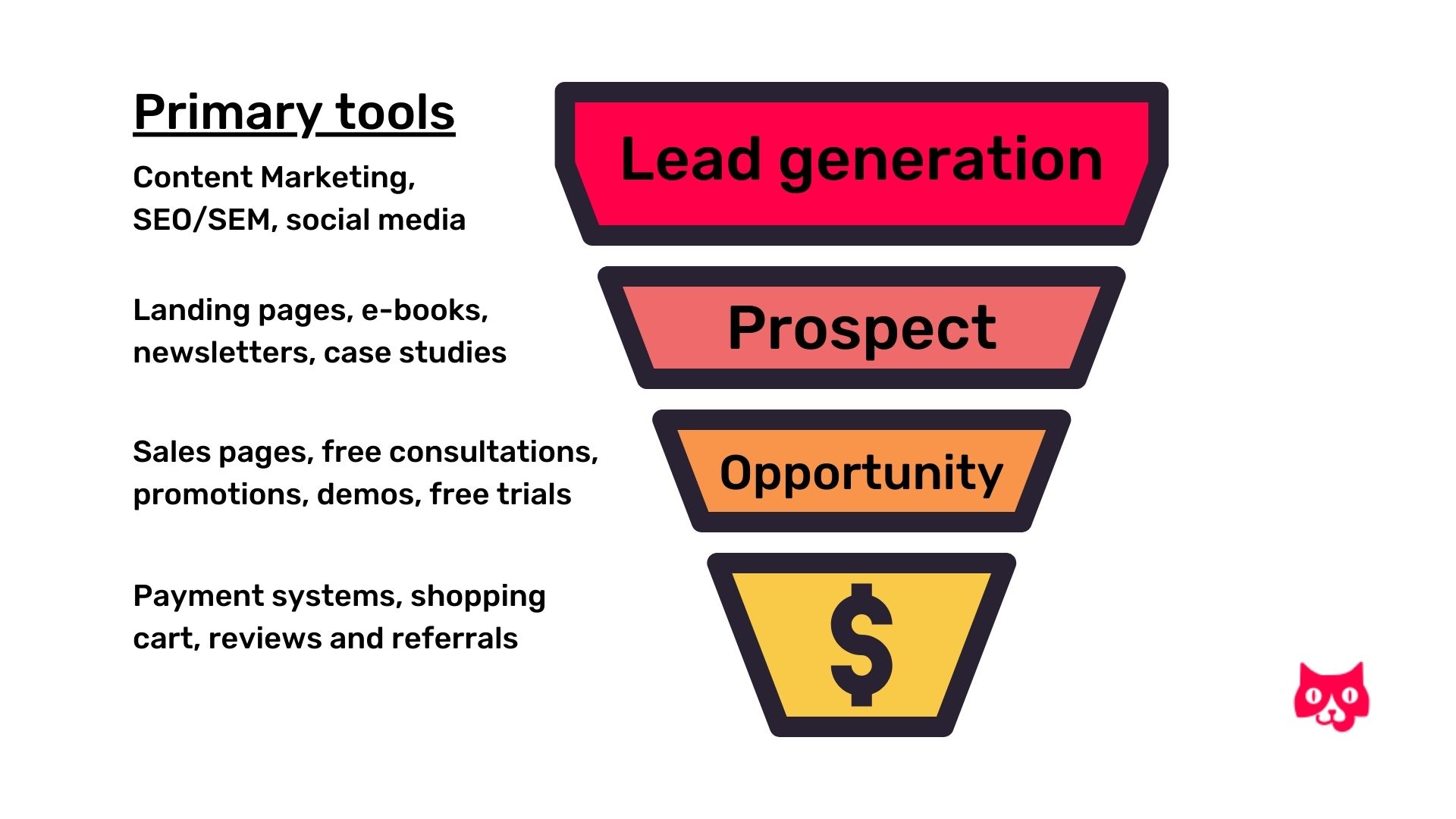Your content department can and should produce clearly defined KPIs that align within a company’s wider funnel.
Working together with growth, SEO, product and sales, content can help support every department—as long as you set KPIs that will support them back.
To help, we’ve curated a list of 17 of the most important marketing metrics to track to help you meet your business goals.
We asked content marketers who have successfully driven business-driving content strategies from various online marketing communities and forums to gather the top 17 metrics we listed here.
What are content marketing metrics?
Content marketing metrics are the indicators you can track to determine the performance of your content.
Not all indicators are the same—different metrics provide insight for different elements of your content marketing efforts.
There are hundreds of different content marketing resources that experts use to track the ROI of different key metrics, and even though your success with content marketing will vary depending on the strategy, these 17 metrics are sure to help you reach your marketing goals.
Why content marketing metrics are important to track
Tracking the right metrics means you’ll align your strategy to the right metrics. Content can help almost any department: SEO, product, growth, sales…metrics help the content team know what kind of content to create and why, and then helps them see whether they’ve succeeded in doing that or not.
17 content marketing metrics to help align with business objectives
We asked content marketing practitioners. They swear by these 17 metrics for content marketing, and also explain how you can track them.
Qualified traffic
Qualified traffic is not just the amount of people that visit your page. It comes with increased engagement and conversions for your business.
An example of this can be a greater amount of time spent on your page, which implies that you’re attracting the right audience.
Kayla Voigt, CEO of KL Voigt Writing Co., says “the most important metric should be the one that measures the success of your goals.
Some content marketing programs are built for lead generation, some are built to drive sales calls, and some are built for traffic.
You should measure based on the goals down to the individual post — if the CTA is to fill out a form, then it won’t be helpful to track something else!
To me, though, the most effective use of content is traffic for prospects. I tend to use unique sessions’ total month over month and per post for traffic metrics, and track SEO positions over time.”
Namratha Ambat, Senior Marketing Specialist at GemPool, says one of the most important metrics to track is website traffic.
“Using Google Analytics (GA), you’re able to track how many visitors a particular piece of content brings to your website.
It also helps you learn more about the spikes and drops in terms of traffic. Which helps you make a more educated decision on when to release a particular piece of content.”
You need to be paying attention to the ups and downs with your audience’s engagement because if you publish something they aren’t interested in, and you aren’t aware of that, you can continue to make that same mistake.
You want to be sure you’re aware of what your audience wants from you during the content creation process.

Kevin Miller, digital marketing expert, says “the traffic to your site is what then enables engagement and conversions.
To know the traffic a piece of content generates for your site, you can find out in Google Analytics. In the main menu, click on Behavior » Site Content » Landing Pages.”
Blake Smith, digital marketing consultant, says “one of the one important content marketing metrics I track is traffic at a landing page.
This tells me how many sessions are starting with my content and what’s happening on that journey.”
Eric Carrell, Marketing Advisor at SurfShark, says, “SEO is an important aspect of your content marketing strategy, and it’s where organic traffic originates from.
Organic traffic is traffic that comes from showing in search engine results pages (SERPs) without having to pay for it.
It’s crucial to keep track of your overall organic traffic so you can monitor how many people are coming to your website as a consequence of your content strategy.
Your content’s performance can be evaluated by tracking organic traffic to your blog and landing pages.”
User engagement metrics
It’s not always necessarily true that if your users don’t engage with your content, you’re doing something wrong.
But you should still try to create content that drives your audience to want to interact with what you’re putting out.
Kayla Voigt, CEO of KL Voigt Writing Co., says “the most underrated [metric] is engagement! Engagement is what tells you whether or not your content is actually resonating with your audience and doing its job.
Marketers HATE engagement because it’s fuzzy and not always easy to understand, but it gets to the heart of your performance more than other metrics.
If you’ve written something worth reading, that tells a story, that helps your audience solve a problem, the engagement is what is going to tell you whether or not you’re successful.
If you don’t know why what you’re doing is working, you’ll never be able to recreate it.
Measuring engagement really depends on the actual content model you’re using. If you don’t have comments enabled, then time on page/bounce rate is a good indicator of engagement.
Video views/view time, webinar attendees that stay until the end, and number of shares on social are other ways to get at engagement.”
Kevin Miller, a digital marketing expert, says “on-page engagement are the actions taken while on your web page.
This could be subscribing to a newsletter, scrolling down to read further, or even watching a video. When a user clicks to watch a video or expands a section, etc., they are showing interest in the site content.
If users aren’t clicking on these options, then it is important to dig into why. Studies have shown that better UX metrics lead to higher rankings and more traffic.”
Unique pageviews
Unique pageviews are all the different pages a visitor enters in a unique session.
Samantha Russel, Chief Evangelist at Twenty Over Ten, says “While there are many different metrics to track, one of the most important ones is “Unique Pageviews” as these determine how many times each user has viewed a page, so it excludes repetition which helps to make measuring more accurate.”

Backlinks
Link-building is one of the most trying parts of content marketing and SEO, but it’s a great benchmark to measure how valuable your content is to your audience.
Jozef Raczka, Content Executive at Twinkl, says “whether you look at it as Domain Authority, Domain Rating, or other, measuring how well your domain is doing and whether the links you’ve built are making a difference really matters.
Not only does it show what sort of sites actually make a difference (showing you what work you’re doing does and doesn’t matter).
It also can’t be forgotten that DA/DR are one of the most easily applicable metrics when it comes to competitor analysis allowing for more honest and accurate comparisons.”
Hamna Amjad, Content Marketing Executive at Efani, says “The most underrated content marketing metric is the number of Backlinks.
Number of Backlinks: Backlinks are one of the top three of Google’s ranking factors.
It’s a great metric for measuring your content quality because if there are more backlinks to a content piece, it tells Google that your content is providing value to the users and is being well received by your audience.
Moreover, the more backlinks a page has, the more organic traffic it gets from Google. We use Ahrefs Backlink Checker to keep track of the number of backlinks each page is getting on our website.”
Leszek Dudkiewicz, Head of Marketing at Passport Photo Online, says “the most important content marketing metric I track are backlinks. This is also the most underrated metric by marketers.
Imagine the whole internet as a 3D spider’s web and each website as an intersection of various single nets. The more nets overlap, the greater and stronger a specific weave is.
Those nets are backlinks. Having a lot of links means that you’re creating engaging and valuable content.
These “votes” are also one of the most crucial SEO and website ranking factors. I track backlinks by using SEO tools like Ahrefs.”

Average time spent on page
This key performance indicator is important since it helps you understand if people are actually spending time reading on your page.
Joe Barron, content manager at Cognism, says “my most underrated content marketing metric is average time on page. It’s overlooked by a lot of content marketers but I think it can be very valuable.
It shows you which blogs people are spending the most time on. It’s a good indicator of quality and it can give you a steer on future content.
For instance, if you publish a blog that gets a high average time on page, it shows that your audience is engaged with the topic and they’d likely be interested in reading more.”
Marc Bromhall, CMO at Beginner Surf Gear, says “the most important metric I track is time on page.
I think that it is one of the most underrated metrics in content marketing as it’s the only metric that truly gives you feedback on the quality of your content.
Social shares are vanity metrics.
Bounce rate is meaningless because the definition of a bounce is those visitors not going to view additional pages—once someone has fulfilled their search intent why would they visit other pages on your site.
I create content that on average takes at least a couple of minutes to read.
If I notice that dwell time for a particular page is below a minute, then I know that the content quality of that page is not good enough.”
Nick Mattar, Found and CEO of Digital Detroit, says “while this number can be misleading sometimes (such as leaving a tab open) it is generally a good indication of how engaging your website truly is.
It also tells you if your content is resonating with your audience.
Other metrics, like average time on page or bounce rate, don’t tell the whole story: we want to see how well your entire site performs and how well it keeps people engaged.
This can be tracked by Google Analytics—nothing tricky here.”

Revenue
The bottom line is this: businesses need to be making money in order to stay operative.
Joe Barron, content manager at Cognism, says “the most important metric for me managing content at Cognism is revenue – knowing which content pieces have directly led to new revenue being generated for the business.
It’s important because it’s what all SaaS/startup marketing is measured on. If your content isn’t producing any deals or revenue, then you’re failing badly.
It also tells you which content pieces are resonating with your audience, meaning you can double down on those themes/topics in future content.
To track this, make sure UTM tracking is set up across your content. You also need to be confident with creating your own, content-based tracking links.
If those 2 things are in place, you can create Salesforce dashboards that display the revenue that your content’s producing month-on-month.
The data you’ll get is priceless. You’ll be able to directly link specific content pieces back to revenue. That’s how you prove to your organization/C-suite that what you’re doing is worth it.”
Tom Bangay, Director of Content at Juro, says “the most consistently underrated metric in content marketing is revenue. It’s the only metric that matters.
Some metrics like traffic or social reach are often vanity metrics—traffic has no inherent value unless you’re selling ads, for example. Conversions, MQLs, and even SQLs can be gamed to an extent.
The one metric my team and I concern ourselves with above all others is revenue, and I make sure our bonuses are tied to it, because if you can’t prove that your content is influencing revenue in an attributable way, then you’re probably doing the wrong things anyway.”
Namratha Ambat, Senior Marketing Specialist at GemPool says that conversion rates is one of the top content marketing metrics to track.
“This can be tracked by the number of leads you generate through a form you have on your website and can be monitored using Google Analytics again.
Conversion rate matters if you’re looking to capture leads (like we do) while making our content downloadable.
Then the number of conversions has helped us determine the success of our content piece and the leads generated are then added into our marketing campaigns, thereby allowing us to deliver more content to our audience.”
Organic shares
Gerald Lombardo, Co-Founder of The Word Counter, says “content marketers obsess over likes, comments, CTR, and paid media ROI.
However, perhaps the most significant metric is the amount of organic shares a feed post generates.
Indeed, this will demonstrate the power of your content, as well as the influence that your organic content has within the confines of both your pre-existing and newfound audience.
Specifically, the best way to track it is via Instagram’s post metrics + analytics. The more shares there are, the more likely your brand/company will acquire new customers that have not engaged with you previously.”
Tyson Stevens, Founder of EduRef, says “content marketing and social media go hand in hand. You can instantly market material to a big audience and grow your following by using social media networks.
A viral effect is also created by social sharing. This is why tracking the number of social shares in your content initiatives is a good idea.
You can reach a large audience without spending any additional money by publishing content and having it shared.
Within each platform, you may track how many social shares your work receives.
For instance, you may monitor the number of retweets, Facebook shares, and Pinterest pins that your content receives to see how well it performs on social media.”
Sally Stevens, Co-Founder and Marketing Director of FastPeopleSearch.io, says “the most qualitative metric that I’ve seen many people neglecting lately has been social media reactions.
After all, what does any one post really matter if no one’s talking about it on Twitter or Facebook!
There are plenty of tools out there for this now, ranging from Radian6 to Sysomos, so make sure your strategy considers how important these ‘soft’ metrics can actually turn out to be regarding content marketing success.”
Page value
Blake Smith, digital marketing consultant, says “one of the most important content marketing metrics I track is page value. I recommend all sites set up values for their conversion goals.
As an e-commerce store or publisher, this is easy (use transaction value for e-commerce or and revenue for publisher) but for lead generation sites you can set up values for your conversion goals based on how they impact your bottom line.
Analytics then automatically reports on the value of that page (page value) in relation to how it helps achieve those conversion goals.”
Want content that helps drive business objectives?
We help fast-growth B2B SaaS companies create revenue-driving content assets.

Bounce rate
Bounce rate may be one of the most misunderstood performance indicators. A website’s bounce rate shows how many people visit your site and leave right away without interacting at all.
Although Google doesn’t see bounce rate as a ranking factor, it’s important to understand how it works. A high bounce rate isn’t necessarily a bad thing if you take the diversity of the queries into account.
For example, visitors landing on a page from the search ‘what day does Hanukkah start in 2021?’ won’t stay on the page once they have the answer to their question.
In that instance, the bounce rate will be pretty high, but it’s not a bad thing. You’ve satisfied the search intent.
Hamna Amjad, Content Marketing Executive at Efani, says “I am responsible for creating content that increases consumer trust and brand affinity.
Content marketing has many metrics that need to be taken into consideration. The most important content marketing metric that we track is bounce rate.
This metric shows whether your content is able to create engagement and entice website visitors to get involved in your content.
It actually refers to how many people navigate away from the website immediately after landing on a website and there can be a number of different reasons:
- Poor user experience
- Quality of content
- Loading speed
All these things can affect the visitors and compel them to move forward without showing interest in your website. If this one metric is corrected, the website may attract multiple users.
We use Google Analytics to keep track of this metric – simply divide the number of single-page sessions by the number of total sessions on the site.”

Quality content
‘How can quality content be a trackable metric?’ you ask.
High-quality content by itself isn’t trackable—the way your audience engages with it is.
Anu Ramani, Managing Director at Isoline Communications Limited, says, “to track the quality of content and keeping users engaged, we have devised a blended metric that combines scroll depth, time spent on page, and goal completions – whether that is clicking on the next article in the journey or the ‘contact us’ button.”
Another way content marketers measure the quality of their content is it’s SEO score. While this alone does not equal quality content, it is a helpful indicator on elements you have done well or should improve.
Natalie Luneva, Co-founder and CMO at Outranking, says “I think most content marketers and writers have an incomplete approach to tracking the quality of content.
Most of them start tracking content performance when it’s already live on the website and they pay attention to a narrow set of metrics—organic click-through rate, impressions, etc.
Of course, these metrics are extremely important but what if you could get immediate feedback on how well SEO-optimized your content is or is not?
Content marketers and editors can check how well their content is optimized even before it’s published—by tracking the content’s SEO score, a metric available on outranking.io.
The SEO score is determined by combining various sub-metrics—word count, number of internal and external links, readability, whether all potential keyword groups are being used, etc.”
Another tool you can use to get an SEO score for your content is Clearscope. We use it for our blog posts, and it provides a content grade and readability score as well.
Mobile entrances
Mobile activity makes up around half of all web traffic worldwide, so if you aren’t paying attention to that side of your content—how it looks, how visitors interact with your content via mobile—you’re already at a massive disadvantage.
Darshan Somashekar, Founder & CEO at Spider Solitaire Challenge, says “today’s internet consumers prefer to browse on their mobile devices.
Are you keeping track of how many individuals visit a content page via mobile? Check if your site’s mobile optimization is high.
This is critical for content marketing as well as overall site ranking. In its evaluation of your website, Google places a premium on mobile page load speed, which is a critical factor for mobile customers.
Pages must also look good on mobile, which should be the case if you have a responsive website.”
Email engagement rate
Erin Stone, Head of Content Marketing at Hinterland Co., says “When it comes to content marketing metrics, your email engagement rate is important.
It’s often overlooked because it’s not directly related to your content, but it is relevant and important. After all, how do most folks find out about your content?
Although the answer might be social media for some, for most it would be through email newsletters.
And if your engagement rate is low, your marketing efforts will suffer. Any analytics tool that you use should come with this capability in order to track it.”

Lead generation
In the sales funnel of any business, the widest section is dedicated to raising brand awareness and generating leads.
Richard Lubicky, Founder of RealPeopleSearch, says that “lead generation is the most important metric when it comes to content marketing analysis.
That’s because the metrics like page views, traffic, traffic source, and user behavior are analyzed to know if you will be getting any leads or not.
Now, the reason to choose lead generation over conversion rate is that content marketing focuses on generating leads only.
On the other hand, conversion rate plays a crucial role in the bigger picture, i.e., overall marketing campaign tracking.
Thus, when we talk about content marketing specifically, lead generation is the most important metric you should look out for.”
Nick Mattar, Found and CEO of Digital Detroit, says “for us, the most important metric is new lead inquiries.
Leads are the crux of new business and if somebody fills out our form, we know our content is doing its job.
We track this through Google Tag Manager so we can usually tell how many times a visitor comes to our website before filling out the form (it’s usually between three and four times before they actually fill it out).”

Impressions
The number of impressions shows the amount of time your content has been seen by users. Banner ads in a page a user loads count as an impression, and so do views when scrolling through your feed.
Nathan Hughes, Marketing Director at DiggityMarketing, says “marketers often neglect impressions when they shouldn’t.
They focus on engagement metrics like the number of likes and comments because most platforms’ algorithms push content with high engagement. However, I believe impressions are as important as any other marketing metric.
It is a common belief that impression does not mean engagement. That’s true, but it does tell us how many unique individuals our content has reached.
Good content impacts audiences’ minds, even those who do not like or comment.”
One powerful tool for tracking impressions is Google Search Console (GSC).
Returning visitors and Customer retention rate (CRR)
If people keep coming to your site, that’s because you’re showing them content they enjoy, and that’s great! But how would you know that audience is who you should hone in on if you aren’t tracking this metric?
James Dyble, Managing director at Global Sound Group says “returning visitors [are] one of the most important metrics that we consider.
The data helps determine whether the audience finds the information relevant, meaningful, and good enough to come back for more in the future.
If the number of repeat visitors is minimal, it is clear that not enough is happening to keep them engaged in the material; thus, nothing encourages them to return.”
Andreyana Kulina, Digital Marketing Specialist at Brosix, says “building good relationships with current customers and gaining their loyalty are crucial to building a good brand image.
Loyal customers generate more referrals and that helps winning new visitors on the website who are ready to try the product we offer.
We are always open for comments, questions, and new ideas for our content. Creating surveys or making customer interviews are our preferred methods to better understand our key customers.”
Cost-per-visitor (CPV)
Unlike Pay per Click (PPC), the cost per visitor is a metric that only expects you to pay for your advertisement based on the total number of new store visits a piece of content brings in.
Javen Yap, Editor in Chief at Good Noise Music, says “the cost per visitor is a pretty accurate way of assessing if a marketer’s content strategy is working.
For example, if the cost per visitor for a certain month was $5 and their goal was 10 visitors then they might need to create or divert more traffic in order to gain more followers on social media.
Or maybe it’s time for them to come up with better quality content. In any case, it helps you determine what metrics are the most important ones in your marketing efforts.
You can easily abandon low-performing channels or ideas because you set yourself expectations from the start!
I’ve found that the following algorithm is what you should be looking for when trying to find the cost-per-visitor for your site.
Cost/Visitor = (Total Site Income) ÷ (Number of Visitors)
So, for example, if your total site income is $500 and your number of visitors is 1000, then I would estimate that you’re making five dollars per visitor. Obviously, this estimation could vary greatly depending on how much money you made off a single visitor.”

Keyword rankings
If you’re distributing your content through search, keyword rankings will be an important metric to track.
Ashley Regan-Scherf, Content Marketing Executive at RGC Advertising, says “keyword rankings allow us to monitor the success rate of our content marketing strategy.
Keyword ranking refers to the position of a specific page on search engine results for a target query. The success rate of keyword rankings and article rankings show how relevant your material is to the user’s search intent.
Our SEO keywords are focused on non-branded queries related to our services, such as “digital marketing agency”.
In our on-page and off-page articles, we use a high density of our targeted keywords in the content.
As a result, Google gives our domain a higher authority ranking as our websites relate heavily to these keywords, ensuring our website is one of the top results on search engines.
Although keyword ranks change continuously, we mainly use SEMrush to monitor/track our progress. If we notice a sharp decline in rankings, this indicates we must produce more content with a heavy influence on our keywords.”
Key takeaways about content marketing metrics
It’s important to measure the right content marketing metrics for your business goals. If you’re trying to assess a new SEO tactic, for instance, maybe a good KPI would be organic traffic to a number of pages on your site.
Even still, there are some that are applicable to just about any strategy and can help nudge you closer to meeting your business goals.
Frequently asked questions about content marketing metrics
Some of the most asked content marketing metric questions, answered.
What are some good goals of content marketing?
Some good goals to set for content marketing are to create a loyal customer base, generate more revenue, improve customer retention rates, and grow your brand authority.
What are the four key types of content metrics?
The four key types of content metrics are consumption/engagement, sharing, sales, and lead generation.
